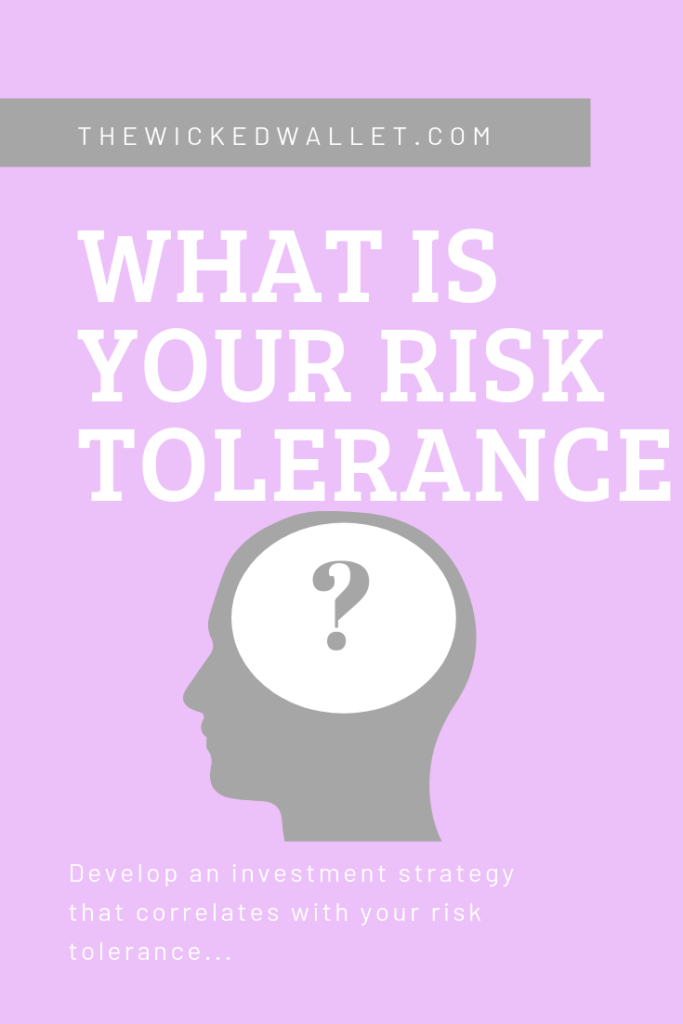
Do you define yourself as a risk taker or daredevil? Or would you say that you tend to be more of a cautious person? Understanding your risk tolerance is crucial for your financial goal setting and overall success. Before you jump right into investing, do some self reflection to figure out your tolerance level.
What is Risk Tolerance?
Investopedia defines risk tolerance as “the amount of risk that an investor is comfortable taking or the degree of uncertainty that an investor is willing to handle”.
When determining your risk level tolerance think about your reaction to losing any amount of your investment. High risk investments offer the potential for high returns but also large losses. Whereas low-risk investments offer lower potential returns but also lower risk of loss. Here are investment examples for three different types of risk tolerance:
High Risk Tolerance Investments
Penny Stocks & Cryptocurrency: these types of investments are extremely risky. Generally, there is not enough quality information available to appropriately evaluate these investments, which then leads to speculative investing.
To learn more about cryptocurrency check out this article – Blockchain: The Fundamental Technology Behind Cryptocurrency
Moderate Risk Tolerance Investments
Index Funds: fall into a risk level that is quite moderate. Index funds follow the market which makes them susceptible to losses from economic down turns. However, with this moderate risk you can expect moderate returns.
To learn more about index funds read this: Everything You Need to Know About Index Funds & ETFs
Low Risk Tolerance Investments
U.S. Treasury Bonds: This type of bond is basically a loan to the government. In return the government pays back the loan with interest over a fixed period of time. The overall return is low but the investment is pretty much risk free. The U.S. government has never defaulted on a bond which is a solid guarantee that your investment is secured.
For more information on bonds check out this article from thebalance.com: The Basics of Bonds
Changing Risk Tolerance
Generally speaking, your risk tolerance can and most likely will change over time. Someone closer to traditional retirement age is most likely going to be very risk averse with their investments. Lower risk investments are much more appealing to them because they don’t want a big loss to impact their retirement fund.
Someone much younger say in their 20s’ may have a much higher risk tolerance because of the mindset that they have nothing to lose.
However, age isn’t the deciding factor for your risk tolerance. There are plenty of 20 somethings that are very risk averse with their investments and plenty of 60 somethings that are risk takers. Yes, your age should be taken into consideration when deciding how to invest your money but what really matters is who you are at the core.
For some, seeing their investment drop by 50% is agonizing yet for others it’s just another day. How would you cope with something like that? Would you be more comfortable earning a more guaranteed return at a much lower rate, or are you willing to take a risk and hit big? The truth is there is no wrong answer, so stay true to yourself.
What is Risk Capacity?
As you begin your investment journey it’s important that you set a goal for your investments. Your goal should include two things: 1) the amount you want your money to grow to and 2) the time frame that you want to accomplish this goal.
Once you have established your goal you can begin developing your investment strategy and this is where risk capacity comes into play.
To learn more about setting financial goals read this: 3 Tips for Financial Goal Setting
Your risk capacity is the amount of risk you will have to take in order to accomplish your investment goals. This will allow you to choose investments that will advance you towards your goals.
The problem with risk capacity is that it does not always align with an individual’s risk tolerance and creates a gap.
The Risk Gap
The truth is your investment goals may not be in line with your risk tolerance which creates a gap.
For example, you may want to triple your initial investment in 3 years but have a very low risk tolerance. The type of investments that you feel most comfortable investing in won’t allow you to reap these financial returns.
If you find that your goals don’t align with your risk tolerance then you may have to reevaluate your investment goals or adjust your risk tolerance.
First, consider how realistic your investment goals are. If your investment goals require you to invest all of your money in high risk assets to even have a shot at making your goal, then you may need to take a step back and reconsider your goals.
Ideally you want your risk tolerance and risk capacity to be aligned in order to effectively invest towards your goals.
Closing Thoughts
Understanding yourself on an emotional and psychological level will help you develop your risk tolerance. Once you understand your risk tolerance you should create a goal for your investments that makes sense with your level of risk tolerance.
Human behavior and emotion can have a huge impact on investing. Therefore, it’s important that your goals are in line with your tolerance and you don’t allow your emotions to have an impact on your goals.
If you enjoyed this article please share and leave comment below.
For more wicked reads on investing check out these posts:



